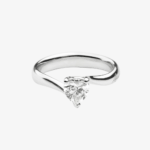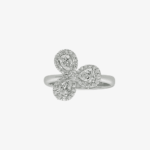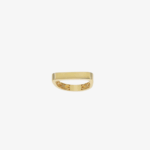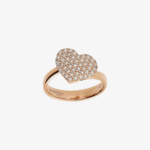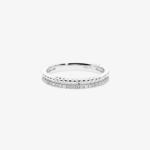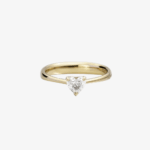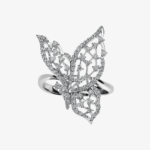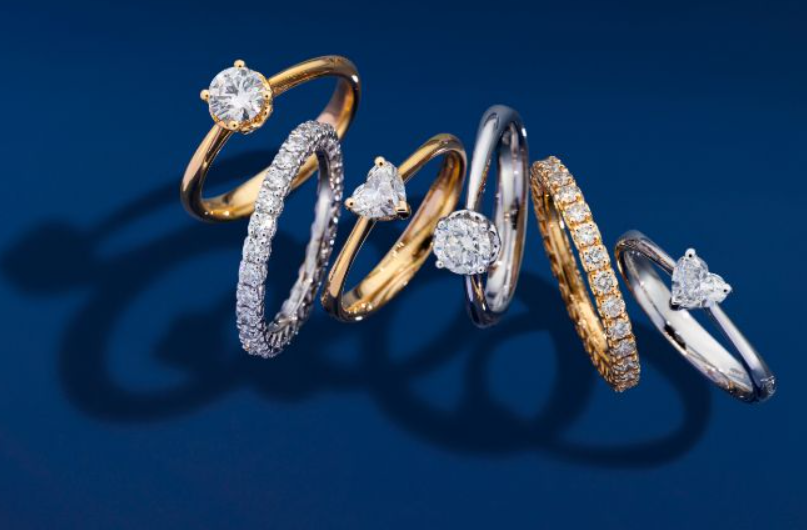
11 Aug Rings: 10 Surprising Secrets and Fascinating Meanings
Rings have captivated humanity since time immemorial. Beyond their beauty as jewelry, rings carry centuries of history, symbolism, and tradition. From ancient civilizations to today, these small circular pieces have represented power, love, commitment, and family legacy.
For example, the collections by Recarlo, Leo Pizzo , or Suïssa Joiers offer contemporary examples of jewelry rich in symbolism—perfect for gifting or wearing on special occasions.
In this article, we’ll explore the origin of rings, the meaning of each of the most iconic types, and the special occasions where giving a ring becomes a gesture full of symbolism. Ready to uncover the fascinating secrets behind rings?
Each section of this guide will take a close look at a different aspect of rings. We’ll learn how the first rings emerged thousands of years ago and how their use has evolved over time. We’ll also explore the symbols and beliefs associated with rings (like the famous “vena amoris”) that explain why we wear them in certain ways. In addition, we’ll break down the most important types of rings, from engagement to eternity rings, and what each represents. Finally, we’ll examine the key moments when rings are most commonly given: engagements, weddings, or other meaningful events. Let’s dive into the fascinating world of rings and all they symbolize.
For example, the collections by Recarlo, Leo Pizzo , or Suïssa Joiers offer contemporary examples of jewelry rich in symbolism—perfect for gifting or wearing on special occasions.
In this article, we’ll explore the origin of rings, the meaning of each of the most iconic types, and the special occasions where giving a ring becomes a gesture full of symbolism. Ready to uncover the fascinating secrets behind rings?
Each section of this guide will take a close look at a different aspect of rings. We’ll learn how the first rings emerged thousands of years ago and how their use has evolved over time. We’ll also explore the symbols and beliefs associated with rings (like the famous “vena amoris”) that explain why we wear them in certain ways. In addition, we’ll break down the most important types of rings, from engagement to eternity rings, and what each represents. Finally, we’ll examine the key moments when rings are most commonly given: engagements, weddings, or other meaningful events. Let’s dive into the fascinating world of rings and all they symbolize.
History and Origins of Rings
The First Rings in Antiquity
The history of rings dates back thousands of years. Early civilizations forged and used rings, initially as symbols of power and status. According to historians, the ancient Egyptians were among the first to use rings to seal their unions, around 5,000 years ago. In ancient Egypt, wearing a ring carried deep meaning: the circular shape represented an unending cycle, symbolizing eternity and the couple’s immortal love. In fact, hieroglyphs have been found showing couples exchanging rings as part of their marriage ritual. These early Egyptian rings were often braided from materials like papyrus, hemp, or leather, before metal became the preferred medium. At the same time, pharaohs and high-ranking Egyptian officials wore gold signet rings engraved with their names and titles to authenticate documents. This showcased both authority and wealth.The ancient Greeks adopted the use of rings from the Egyptians after Alexander the Great’s conquests. For the Greeks, rings were often ornamental: they featured engraved stones depicting figures like Eros (Cupid), the god of love, symbolizing devotion. Later, during the Hellenistic period, embedding gemstones such as garnets or emeralds in rings became popular, enhancing their beauty and value.
In ancient Rome, rings gained significant social and legal importance. During the Roman Republic, wearing rings signaled social status: only patricians and high officials could wear gold rings, while others wore iron. Over time, this distinction faded, and by the 3rd century AD, nearly any free citizen (except slaves) could wear a gold ring . More importantly, it’s believed the Romans originated the tradition of the betrothal or engagement ring as a formal promise of marriage. In Roman weddings, the man gave the woman a ring (often iron) to formalize the agreement. In fact, in ancient Rome, only the woman wore a wedding ring, symbolizing her transition from her father’s authority to her husband’s. These early Roman wedding rings had more legal and practical meaning than romantic: they indicated a contract and even a form of ownership over the woman. A common Roman design was the “fede” ring, with two hands clasped together, a symbol of agreement and fidelity.
Today, that symbolic spirit lives on in pieces like Recarlo’s white gold and diamond ring, which evokes commitment and timeless elegance.
From Symbols of Power to Symbols of Love Over Time
Over the centuries, the function and meaning of rings evolved significantly. During medieval Europe, wearing a ring could indicate both social rank and religious devotion. Kings and nobles used official signet rings to seal documents, and the Catholic Church incorporated rings into its rites: bishops were given episcopal rings, and the Pope awarded a special ring (such as the Ring of the Fisherman) to cardinals. At the same time, rings with various symbolic purposes emerged: memorial rings with inscriptions for the deceased, talisman or supposedly protective rings, and even poison rings with secret compartments—popular in legends.Despite these variations, the most enduring use of the ring remained its association with love and marriage.
From the 9th century onward, the Christian influence cemented the wedding ring’s symbolism. Initially skeptical of rings due to their pagan connotations, the Church eventually adopted them into marriage ceremonies. In the 9th century, Pope Nicholas I decreed that wedding rings should be made of gold, symbolizing the purity and nobility of the bond. Thus, the simple gold band was blessed during the ceremony and became a sacred part of marriage. Over time, especially in the late Middle Ages, rings began to be adorned with gemstones. Diamonds came to represent the strength and durability of love, while rubies symbolized passion and sapphires the heavens and fidelity. A notable milestone was in 1477, when Archduke Maximilian of Austria gave Mary of Burgundy the first recorded diamond engagement ring, setting a trend among the nobility.
Today, rings like the Venezia ring with white diamonds by Leo Pizzo evoke that historical elegance with designs inspired by Italian tradition.
In modern times, ring-wearing became democratized, no longer exclusive to the upper classes or ceremonial occasions. In the 19th and 20th centuries, traditional distinctions between ring types blurred, and many people wore rings simply as ornaments or fashion statements. Still, wedding and engagement rings maintained their central role as symbols of love and marital fidelity. A current example of this refined and timeless classic gold wedding band from Suïssa Joiers
, perfect for representing a lasting bond.
Today, we inherit this rich legacy: from humble Roman iron bands to luxurious platinum and diamond rings, each ring we wear carries a piece of history and deep symbolism of eternal love.
The Eternal Symbolism of Rings
The Infinite Circle: A Symbol of Eternity
A ring is, at its core, a perfect and uninterrupted circle. This circular shape, with no beginning or end, has always symbolized eternity. In ancient cultures, the circle represented the infinite cycle of life and nature. For example, Egyptians associated rings with the shape of the sun and moon, sacred elements, and saw the circle as a symbol of eternal love and immortality. When a couple exchanges rings, especially in the context of marriage, they express that their bond is forever, love has no end, just like the circle of the ring.Moreover, the hole in the center of the ring holds poetic meaning too: it represents a door or portal into the unknown. Some say that giving a ring means opening the door to a new chapter (a marriage, a commitment, a deep friendship) where two people step together toward the future. In this way, the ring symbolizes not just continuity, but also the significant step two people choose to take together.
In many cultures, the ring’s material also carries symbolic meaning. Precious metals like gold and silver, known for their durability and untarnished shine, represent purity, strength, and enduring bonds. Gemstones set into rings often have meanings of their own: for example, diamonds (for their extreme hardness) symbolize the strength of love; blue sapphires evoke the sky, representing fidelity and truth; red rubies signify intense passion. The design and materials of a ring thus combine to reinforce its symbolic message.
For instance, the Princess ring with white diamonds and rose gold by Leo Pizzo is ideal to symbolize a sweet and committed passion, while the white gold ring from Suïssa Joiers conveys purity and elegance for an eternal bond.
The “Vena Amoris” and the Ring Finger
A widely shared tradition explains why we wear the wedding ring on the ring finger of the left hand. According to an ancient belief (attributed to the Egyptians and later adopted by the Romans), this finger contains the vena amoris or “vein of love,” a vein believed to run directly to the heart. Placing the ring on this finger would symbolically mean that the heart of your beloved is forever connected to yours through the ring. It’s a romantic idea that has lasted through the centuries, even though anatomically, the vena amoris doesn’t exist (all fingers have similar blood flow and no single vein connects directly to the heart). Still, the beauty of the idea has kept the tradition alive: in many Western countries, couples place their wedding rings on the left ring finger in homage to this romantic legend.It’s worth noting that the hand on which the wedding ring is worn can vary depending on culture. For instance, in Catalonia and much of the world, it’s commonly worn on the left hand. However, in some European countries such as Germany, Russia, or Poland, it’s traditional to wear it on the right. In Catalonia, some couples wear the engagement ring on the left, and after marriage, move it to the right to make space for the new wedding band. In any case, regardless of hand or finger, the essential point is the deep symbolism: the ring represents the union of two hearts in love.
Types of Rings and Their Meanings
The Engagement Ring (Marriage Promise)
The engagement ring is perhaps one of the most exciting and meaningful rings one can give. It represents the promise of marriage: when someone gives their partner an engagement ring, they are formally asking them to marry and sealing the proposal with a highly emotional piece of jewelry. It is usually given during the proposal, an intimate and special moment for the couple. The engagement ring typically features a prominent gemstone, traditionally a solitaire diamond, symbolizing the purity and strength of love.
A perfect example is the Anniversary Love ring with heart-shaped diamond by Recarlo
, a piece that combines delicacy and commitment in a refined and timeless design.
The Wedding Band (Lifelong Union)
The wedding band is probably the most universally recognized ring as a symbol of love and union. It is the ring exchanged between spouses during the wedding ceremony, accompanying their vows. At the moment when each person places the ring on their partner’s finger and says “I do,” the ring becomes the tangible symbol of their marital bond.
Historically, the Church favored plain bands to reject pagan extravagance, hence the idea of the unadorned gold ring. Over time, customizations have emerged (engraved names or dates, small diamonds, two-tone designs), but the essence remains. The Fine white gold wedding band by Suissa Joïers
perfectly combines traditional simplicity with a touch of contemporary elegance.
The meaning of the wedding band is profound: it indicates a promise of eternal love and fidelity between spouses. Wearing the ring daily reminds the wearer, and shows the world, that they have made a lifelong commitment. Unlike the engagement ring, which was traditionally worn only by the woman before the wedding, wedding bands are worn by both partners after marriage, symbolizing a mutual and reciprocal bond. This small metallic circle becomes a ring of protection around the relationship: a constant reminder of the love, trust, and responsibility shared by both.
Promise Rings and Eternity Rings
In addition to the main engagement and wedding rings, there are other special rings that mark stages and promises in a relationship. Two notable categories are promise rings and eternity rings:
A promise ring may feature a small gemstone or meaningful engraving, but it is generally simpler than an engagement ring. Its meaning is: “I promise to love you and be faithful.” Some consider it a precursor to the engagement ring; others simply see it as a symbol of love without wedding implications. Either way, it is a romantic gesture that strengthens trust and hope for the future, like the white gold and diamond ring from the LightWings collection of Leo Pizzo..
Eternity ring: Also known as an eternity band, this ring is characterized by a continuous line of precious stones (often diamonds) set all around the band without interruption. This design symbolizes eternal, unbroken love. It is often given on a significant wedding anniversary (such as the 10th) or during special moments like the birth of a child, commemorating a new chapter in the couple’s life. The eternity ring is usually given by one spouse to the other and is commonly worn by the woman alongside her wedding band and engagement ring. Its meaning is clear: it represents that the love promised at the wedding remains as strong and infinite as ever, renewing that original commitment. Each diamond on the ring recalls happy moments shared and the many years yet to come.
Special Occasions to Gift Rings
Engagement and Wedding: Key Moments for Ring Exchange
The first situations that come to mind when we think about gifting a ring are, undoubtedly, engagements and weddings. In a marriage proposal, giving a ring (the engagement ring) is the classic way to ask someone to marry you. The proposal is usually an intimate moment, filled with nerves and excitement, where the person proposing often kneels in front of their beloved and offers the engagement ring as a tangible symbol of the question, “Will you marry me?” If the other person accepts, that ring will stay on their finger until the wedding day, signaling to the world that they are engaged. It is a once-in-a-lifetime occasion for the couple, and in this context, the ring represents the hope and firmness of the decision they have made together.Frequently Asked Questions About Rings
Engagement and Wedding: Key Moments for Ring Exchange
The first situations that come to mind when we think about gifting a ring are, undoubtedly, engagements and weddings. In a marriage proposal, giving a ring (the engagement ring) is the classic way to ask someone to marry you. The proposal is usually an intimate moment, filled with nerves and excitement, where the person proposing often kneels in front of their beloved and offers the engagement ring as a tangible symbol of the question, “Will you marry me?”If the other person accepts, that ring will stay on their finger until the wedding day, signaling to the world that they are engaged. It is a once-in-a-lifetime occasion for the couple, and in this context, the ring represents the hope and firmness of the decision they have made together.
Frequently Asked Questions About Rings
What Is the Origin of Rings and Since When Have They Been Used?Rings have existed since prehistoric times as a form of ornament, but their documented symbolic use dates back to the ancient civilizations of Mesopotamia and Egypt. Around 4,000–5,000 years ago, Egyptians were already exchanging rings as part of their marriage rituals. These early rings were made of simple materials (reeds, bones, or primitive metals) and symbolized the eternity of the union. Over time, the Greeks and especially the Romans adopted the use of rings, giving them significant legal and social value. Thus, the origin of rings as a symbol of union is lost in the mists of time, but we know it dates back thousands of years of accumulated history.
Why Do We Wear the Wedding Ring on the Left Ring Finger?
The reason is mainly traditional and symbolic. According to classical belief, the left ring finger contains the vena amoris, an imaginary vein that connects directly to the heart. Although anatomically this is a myth, the tradition has persisted because it’s a beautiful symbol of love linked directly to the heart. Placing the ring on this finger, therefore, means that our heart is bound to our partner’s. Additionally, it’s practical: the left hand is used less (for right-handed people), reducing wear on the ring. It’s worth noting that in some countries, the ring is worn on the right hand (such as in parts of Europe and Latin America). Ultimately, we do it for romantic tradition and convenience, with the left ring finger being the standard location for wedding bands in many cultures.
What’s the Difference Between an Engagement Ring and a Wedding Band?
The engagement ring is given during a marriage proposal, symbolizing the promise to marry. It usually features a prominent gemstone (like a diamond) and is typically worn only by the engaged person from the proposal until the wedding day. In contrast, the wedding band is the ring that the couple exchanges during the wedding ceremony; it’s usually a simpler band of gold or another precious metal that both spouses wear after getting married. The engagement ring represents the intention and the question “will you marry me?”, while the wedding band represents the definitive “yes” and the fulfilled union. After the wedding, some people choose to wear both rings on the same finger (especially women, stacking the engagement ring and the wedding band), although this is optional. In summary: the engagement ring comes before the wedding (promise), and the wedding band is worn during and after (consummated union).
What Exactly Is a Promise Ring and When Is It Given?
A promise ring is a ring that symbolizes an informal commitment or a promise between two people in love. It doesn’t directly imply marriage, but it does reflect serious intentions. It can be given when a couple wants to show that the relationship is progressing and that there is a shared desire for a future together, without yet setting a wedding date. For example, some young couples exchange promise rings to commit to staying together or before going through a period of separation (such as a long-distance relationship), as a sign of loyalty. It is also suitable when, for any reason, a formal engagement is not yet possible, but both partners want to express that the relationship is exclusive and meaningful. The design is usually simpler than an engagement ring (it may feature a small diamond or no stone at all) and is typically worn on the ring finger of the left or right hand, depending on cultural tradition. It represents a promise of love and loyalty in the present, without yet planning the details of a wedding.
How can I determine the correct ring size before buying it for someone?
Choosing the correct ring size is important to ensure the gift fits perfectly. There are several methods: the simplest is to secretly take a ring that the person already wears on the same finger the new ring will be worn (for example, the left ring finger for a wedding band) and bring it to the jeweller to measure the diameter. If that’s not possible, you can wrap a strip of paper or thread around the person’s finger while they sleep or without them noticing, mark the length, and measure it to calculate the circumference (jewellers have standard size charts that convert millimeters into ring sizes). There are also adjustable plastic ring sizers available to discreetly measure at home. Ultimately, if you don’t get the exact size, most jewellers offer resizing services. So try to estimate the size as closely as possible (better slightly too big than too small), and keep the receipt or arrange for a possible adjustment with the store. With a bit of cleverness (and maybe help from someone close to the person), you’ll find the perfect ring size for your gift.
Conclusion
If you’re looking for a place where jewelry doesn’t just shine but tells stories, The Embassy Store is your ideal destination: a boutique where every ring connects with authentic emotions, elegance, and tradition.
In the end, the world of rings is as vast and symbolic as the history of humanity itself. We’ve seen how these small circular jewels have accompanied kings and commoners, priests and lovers, over millennia. From the first woven rings of ancient Egypt to today’s elegant diamonds, each generation has given rings a unique meaning. They are eternal symbols: of never-ending love, unwavering commitment, faithful loyalty, and ultimately, the joy of finding someone to share life with.
Giving or wearing a ring is a deeply meaningful act. It means inheriting and continuing an ancient tradition, while also giving it our own personal meaning. Every time we look at a ring on our finger, we remember a promise made, either to another person or to ourselves. As we’ve explored, there’s a ring for every important occasion and every deep feeling: from engagement rings that start a new chapter to wedding bands that seal a lifelong pact, or rings that celebrate friendship and achievement.
In a constantly changing world, rings keep alive the flame of tradition and core values: love, loyalty, unity, and memory. When we gift a ring, we’re not just offering a beautiful piece of jewelry, we’re giving a symbol filled with all this emotional and historical weight. That’s why it remains one of the most timeless and touching gifts.
Giving or wearing a ring is a deeply meaningful act. It means inheriting and continuing an ancient tradition, while also giving it our own personal meaning. Every time we look at a ring on our finger, we remember a promise made, either to another person or to ourselves. As we’ve explored, there’s a ring for every important occasion and every deep feeling: from engagement rings that start a new chapter to wedding bands that seal a lifelong pact, or rings that celebrate friendship and achievement.
In a constantly changing world, rings keep alive the flame of tradition and core values: love, loyalty, unity, and memory. When we gift a ring, we’re not just offering a beautiful piece of jewelry, we’re giving a symbol filled with all this emotional and historical weight. That’s why it remains one of the most timeless and touching gifts.

